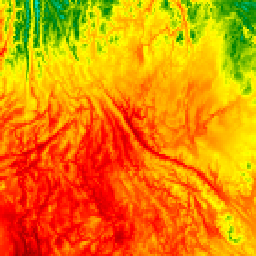Page Summary
-
CHIRTS-daily is a high-resolution, quasi-global gridded dataset providing daily minimum and maximum temperatures and four derived variables from 1983 to 2016.
-
This dataset supports analysis of temperature extremes and variability, particularly in regions with limited station observations.
-
CHIRTS-daily is generated by merging high-resolution monthly temperature data (CHIRTSmax) with daily temperatures from the ERA5 reanalysis.
-
The dataset includes bands for minimum temperature, maximum temperature, saturation vapor pressure, vapor pressure deficit, relative humidity, and heat index.
-
The dataset is in the public domain, with copyright waived by the provider.

- Dataset Availability
- 1983-01-01T00:00:00Z–2016-12-31T00:00:00Z
- Dataset Provider
- UCSB/CHG
- Cadence
- 1 Day
- Tags
Description
The Climate Hazards Center InfraRed Temperature with Stations daily temperature data product (CHIRTS-daily; Verdin et al. 2020) is a quasi global, high-resolution gridded dataset (0.05° × 0.05° resolution, 60°S - 70°N) that provides daily minimum (Tmin) and maximum 2-meter temperatures (Tmax) and four derived variables: saturation vapor pressure (SVP), vapor pressure deficit (VPD), relative humidity (RH), and heat index (HI). CHIRTS temperature products are designed to support analysis of temperature extremes and variability, especially in regions with a low density of station observations.
CHIRTS-daily is created by merging a high-quality, high-resolution monthly maximum temperature dataset, the Climate Hazards Center InfraRed Temperature with Stations monthly maximum temperature climate record (CHIRTSmax; Funk et al. 2019), with daily temperatures from the European Centre for Medium-Range Weather Forecasts (ECMWF) Reanalysis v5 (ERA5). The result is a high-resolution, daily temperature dataset that maintains spatio-temporal information from monthly CHIRTSmax and the daily and diurnal temperature variability from ERA5. Monthly CHIRTSmax are based on:
A Tmax climatology constructed using geostatistical regressions and long-term averages of FAO station observations, ERA5 temperatures, and several other geographic predictors.
Estimates of Tmax variability using approximately 15,000 in situ observations and high-resolution (0.05° × 0.05°) satellite observations. These data are from Berkeley Earth and Global Telecommunication System (GTS) station reports and cloud-screened GridSat geostationary satellite thermal infrared brightness temperatures.
Daily Tmax values are produced using downscaled ERA5 Tmax anomalies and high-resolution CHIRTSmax. Daily Tmin values are created by removing the downscaled ERA5 diurnal temperature range (Tmax - Tmin). Daily SVP, VPD, RH, and HI are computed using CHIRTS-daily Tmin and Tmax, alongside hourly ERA5 inputs for other meteorological variables (see Williams et al., 2024, for details). CHIRTS-daily, version 1, covers the period from 1983 to 2016.
Bands
Pixel Size
5566 meters
Bands
| Name | Units | Min | Max | Pixel Size | Description |
|---|---|---|---|---|---|
minimum_temperature |
°C | meters | The lowest air temperature recorded at 2 meters above the ground surface over a 24-hour period. |
||
maximum_temperature |
°C | 10* | 40* | meters | The highest air temperature recorded at 2 meters above the ground surface over a 24-hour period. |
saturation_vapor_pressure |
kPa | meters | The maximum amount of water vapor that the air can hold at a given temperature and pressure at 2 meters above ground. |
||
vapor_pressure_deficit |
kPa | meters | The difference between the saturation vapor pressure and the actual vapor pressure at 2 meters above ground. |
||
relative_humidity |
% | meters | The ratio of the actual amount of water vapor in the air to the maximum amount it could hold at that temperature and pressure (saturation vapor pressure) at 2 meters above ground. |
||
heat_index |
°F | meters | A measure of how hot it feels when temperature and humidity are combined. |
Terms of Use
Terms of Use
This datasets are in the public domain. To the extent possible under law, Chris Funk has waived all copyright and related or neighboring rights to Climate Hazards InfraRed Temperature with Stations daily temperature data product (CHIRTS-daily).
Citations
Verdin, A., C. Funk, P. Peterson, M. Landsfeld, C. Tuholske, and Grace, K., 2020: Development and validation of the CHIRTS-daily quasi-global high-resolution daily temperature data set. Scientific Data, 7(1), 303. doi: 10.1038/s41597-020-00643-7
Funk, C., P. Peterson, S. Peterson, S. Shukla, F. Davenport, J. Michaelsen, K.R. Knapp, M. Landsfeld, G. Husak, L. Harrison, J. Rowland, M. Budde, A. Meiburg, T. Dinku, D. Pedreros, and N. Mata, 2019: A High-Resolution 1983-2016 Tmax Climate Data Record Based on Infrared Temperatures and Stations by the Climate Hazard Center. J. Climate, 32, 5639-5658. doi:10.1175/JCLI-D-18-0698.1
Williams, E., C. Funk, P. Peterson, and C. Tuholske (2024). High resolution climate change observations and projections for the evaluation of heat-related extremes. Scientific Data, 11(1), 261. doi: 10.1038/s41597-024-03074-w
DOIs
Explore with Earth Engine
Code Editor (JavaScript)
var dataset = ee.ImageCollection('UCSB-CHG/CHIRTS/DAILY') .filter(ee.Filter.date('2016-05-01', '2016-05-03')); var maximumTemperature = dataset.select('maximum_temperature'); var visParams = { min: 10, max: 30, palette: ['darkblue', 'blue', 'cyan', 'green', 'yellow', 'orange', 'red','darkred'], }; Map.setCenter(-104.28, 46.07, 3); Map.addLayer(maximumTemperature, visParams, 'Maximum temperature');